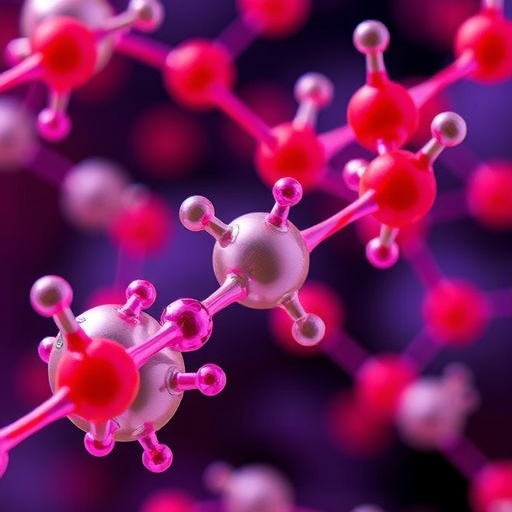In a pioneering advancement at the crossroads of chemistry and biotechnology, researchers at the University of California, Santa Barbara have unveiled a transformative approach that redefines the frontier of enzymatic synthesis. This innovative method harnesses reprogrammed biocatalysts to orchestrate multicomponent reactions, unlocking access to an unprecedented diversity of molecular architectures. Spearheaded by Professor Yang Yang and his multidisciplinary team, and propelled by computational insights from the University of Pittsburgh’s Peng Liu group, the work represents a convergence of enzymatic precision and photocatalytic versatility, enabling the creation of complex molecules that had long eluded both chemical and biological synthetic strategies.
The heart of this breakthrough lies in the concept of diversity-oriented synthesis (DOS), an ingenious strategy aimed at generating structurally diverse compound libraries for high-throughput screening in drug discovery and other applications. Unlike the conventional synthetic paradigms that focus narrowly on specific target molecules, DOS expands the exploratory landscape by synthesizing a broad spectrum of molecular scaffolds with the potential to reveal novel biological activities. The UCSB-led research advances this paradigm by integrating photo-driven processes with biocatalysis, pioneering a synthetic toolkit that not only accelerates the generation of chemical diversity but also imposes exquisite stereochemical control over the resulting products.
Central to this new methodology is the interplay between engineered enzymes and light-harvesting photocatalysts. Enzymes, renowned for their evolutionary-honed specificity and catalytic efficiency, have historically operated within a constrained substrate scope under narrowly defined conditions. Synthetic catalysts, conversely, offer wider substrate tolerance and functional breadth but often sacrifice selectivity and catalytic finesse. By fusing these two catalytic worlds, the research team achieves a synergistic reaction environment. Photocatalysis initiates radical intermediates under mild conditions, which are then selectively channeled by enzymes to form carbon-carbon bonds with remarkable control over molecular geometry and stereochemistry.
The nature of carbon-carbon bonds being the foundation of organic chemistry—as the scaffolding of proteins, nucleic acids, and myriad bioactive molecules—makes their strategic formation a critical challenge and opportunity in synthetic science. The multicomponent radical coupling reactions developed by Yang’s group effectively assemble six structurally distinct molecular frameworks in a single integrated process. These scaffolds exhibit rich stereochemical diversity unattainable by previous synthetic or enzymatic routes, highlighting the method’s capacity to expand chemical space in innovative directions.
What sets this innovation apart is the enzyme-photocatalyst cooperativity, orchestrated through radical mechanisms that facilitate reactions previously unknown to both chemistry and biology. Such multicomponent reactions traditionally required cumbersome procedures, often lacking the efficiency or selectivity desirable for practical and scalable synthesis. The ability of these enzymes to operate across a broad substrate range, combined with the dynamic nature of photocatalytic radical generation, effectively surmounts these hurdles. This provides an unprecedented platform for rapid, combinatorial synthesis of complex molecules under environmentally benign conditions.
From a mechanistic standpoint, the process exploits the complementary strengths of enzyme active sites and photocatalytic radical generation. Upon visible light excitation, photocatalysts induce radical formation from relatively simple starting materials. These reactive species promptly engage in enzyme-catalyzed bond-forming steps, which precisely guide product formation and stereochemical outcome. This cooperative catalysis minimizes side reactions and maximizes yield and stereoselectivity, demonstrating a sophisticated level of control typically challenging to achieve in radical chemistry.
Beyond synthetic efficiency, the strategic value of this research lies in its implications for medicinal chemistry and discovery science. The capability to quickly generate and screen molecules rich in stereochemical complexity provides medicinal chemists with novel leads endowed with enhanced pharmacological and biological properties. The structural diversity inherent in these newly accessible scaffolds could expedite the identification of therapeutic agents with improved efficacy and selectivity, thereby accelerating the drug development pipeline.
The significance of this accomplishment is further demonstrated by the multidisciplinary team effort, including contributions from Chen Zhang, Jun Zhou, and Silvia M. Rivera at UCSB, Pei-Pei Xie and Turki M. Alturaifi at the University of Pittsburgh, and industrial collaborators James Finnegan and Simon Charnock of Prozimix Ltd. This collaborative synergy underscores the growing importance of integrating computational modeling, synthetic methodology, and industrial expertise to solve complex scientific problems.
Funding from the National Institutes of Health and the National Science Foundation underscores the broader scientific and societal interest in such transformative approaches. Their support validates the potential impact of reimagining biocatalysis through photochemical fusion and its role in shaping next-generation synthetic methodologies. The integration of sustainable light-driven processes with selective biocatalysts aligns well with global efforts to develop greener and more efficient chemical manufacturing processes.
In summary, this groundbreaking work not only extends the synthetic capabilities of biocatalysts but also lays down a new paradigm where molecular complexity and diversity are achieved through the synergistic union of enzymatic and photocatalytic processes. The resultant diversity-oriented photobiocatalytic synthesis, characterized by stereoselective three-component radical coupling, promises to ignite further research across organic synthesis, enzymology, photochemistry, and drug discovery. It exemplifies how marrying natural catalytic finesse with synthetic flexibility can redefine the scope and scale of molecular innovation.
This approach opens up exciting horizons for future investigations aiming to tailor enzymatic systems for even broader applications, including asymmetric synthesis of pharmaceuticals, agrochemicals, and materials science. As the chemical community embraces this multidimensional strategy, it sets a milestone, emphasizing that the next leap in molecular science resides at the interface of biology, chemistry, and photonics.
Researchers anticipate that these advances will stimulate a renaissance in combinatorial biocatalysis, inspiring novel enzyme designs and light-driven reaction pathways that can efficiently generate vast molecular libraries. This burst of catalytic creativity holds tremendous promise not only for expanding fundamental chemical knowledge but also for tangible applications in healthcare, sustainability, and industrial chemistry.
Subject of Research: Enzymatic multicomponent reactions enabling diversity-oriented synthesis via hybrid enzyme-photocatalyst systems.
Article Title: Diversity-oriented photobiocatalytic synthesis via stereoselective three-component radical coupling
News Publication Date: 31-Jul-2025
Web References:
https://www.science.org/doi/10.1126/science.adx2935
References:
Yang Y., Zhang C., Zhou J., Rivera S. M., Xie P-P., Alturaifi T. M., Finnegan J., Charnock S., Liu P. (2025). Diversity-oriented photobiocatalytic synthesis via stereoselective three-component radical coupling. Science. DOI: 10.1126/science.adx2935
Keywords:
Physical sciences, Chemistry, Organic chemistry, Combinatorial synthesis, Organic reactions, Organic synthesis, Stereochemistry




